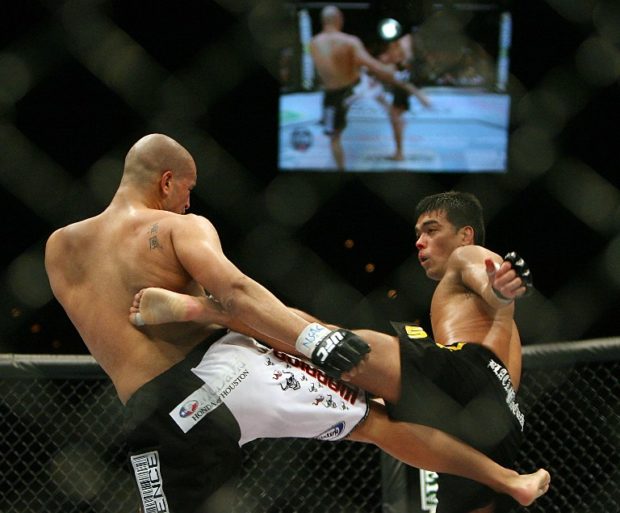
(FILES) This file photo taken on February 4, 2007 shows Brazilian Lyoto Machida (R) fighting with Sam “The Alaskan Assassin” Hoger of the US during their UFC 67: All or Nothing fight at the Mandalay Bay Hotel in Las Vegas, Nevada.
In the space of 15 years, two brothers from Las Vegas have transformed UFC from a little known, somewhat frowned upon brand into the dominant company in mixed martial arts. / AFP PHOTO / GABRIEL BOUYS
In the space of 15 years, two brothers from Las Vegas have transformed UFC from a little known, somewhat frowned upon brand into the dominant company in mixed martial arts.
So much so that it is even competing with more traditional sports.
April 14 will go down as a historic date in the young life of the Ultimate Fighting Championship.
That was the day New York became the last US state to legalize professional MMA fights.
Lorenzo Fertitta, a stocky, well-dressed man of 48 who is the co-owner of UFC, says this is perhaps the last big piece of the puzzle he has been assembling.
“I think it means a lot, because historically, anybody who was a detractor, who was against the sport, first thing they were putting up was, ‘well, you’re not even legal in New York,'” he told AFP.
“So obviously, it takes that argument away.”
Coming from the casino world, Fertitta and his brother Frank paid a measly two million dollars in 2001 for a contest that was known for little more than how violent it was.
Around the same time, the mixed martial arts world developed unified rules that got rid of dangerous fighting moves and set the stage for a new, more respectable image.
But it would be another four years before things really changed with the reality show “The Ultimate Fighter,” in which UFC hopefuls took each other on.
“The Ultimate Fighter drove casual viewers to watch MMA and the UFC that were never really interested before,” said Joe Favorito, a sports marketing specialist.
“They became very quickly educated so they then had a product on free television in the US and in Canada that drove towards their pay per view,” he added.
UFC president Dana White said UFC 196, an event held in March in Las Vegas and featuring Irish superstar Conor McGregor, broke all revenue records for the firm and was watched on TV by 1.5 million paying viewers.
Fertitta said in late December that the company would post revenue of 600 million dollars in 2015.
70,000 people at a fight
Parent company Zuffa was reported earlier this month to be in advanced talks to sell the company — valued at between $3.5 and $4 billion — to a Chinese conglomerate.
But White denied the reports as “overblown,” adding: “The UFC is not for sale.”
The more than 500 fighters the UFC has under contract are independent contractors.
That gives it a big advantage: in traditional major US sports leagues, players belong to unions that are often quite powerful.
UFC does not seem intimidated by its competitors — Bellator MMA, Cage Warriors or M-1 — even though media giant Viacom acquired Bellator MMA in 2011.
UFC markets its product very well, managing to lure sponsors and strike a deal in 2014 with sports apparel manufacturer Reebok.
The fame of some UFC stars, led by American Ronda Rousey, has spread outside the octagon, the name given to the area where UFC fighters battle it out.
Big name stars come to watch, such as actor Leonardo DiCaprio and singer Bruno Mars.
And besides the fights themselves, the company now has UFC Gym, a network of workout spots open to the public.
“I think at first females were a little timid to come in because of the name UFC,” Rich Van Houten, who owns a UFC Gym outlet in Jersey City.
But the brand has done a good job of showing it’s all about learning a new way to work out and that “you’re not gonna get punched in the face,” he added.
UFC says that after TV, sponsorships and sports merchandising and gyms, the sky is the limit.
It has fights planned for November 12 at Madison Square Garden, one of New York’s holiest sports arenas.
Lorenzo Fertitta is talking about staging fights at Yankee Stadium in 2017 with 70,000 spectators, which would be a record there.
Then there is the contract for the right to broadcast UFC fights. It expires in 2018.
UFC told AFP it is the only major championship whose broadcast rights are coming up for grabs before 2021. So interest will be keen.
China and India
Favorito said UFC and MMA may have benefited from the decline of professional boxing but “especially in the digital space they control an audience and a demographic that every brand, every sport in the world, finds desirable which is 18 to 34.”
The championship stages events around the world, such as UFC 198, scheduled for May 14 in Brazil in a football stadium with more than 40,000 seats.
Fight Pass, which lets people watch fights online, is available in 200 countries and territories.
UFC says it is looking into staging its first fight in mainland China and also considering opportunities in India.
To win over naysayers, UFC is counting on educating people as to what mixed martial arts are.
“New York being the most important city in the world in many ways particularly with the media I think it will change perceptions,” said Lorenzo Fertitta.
“Is it violent? Of course it’s violent. Is it controlled? Much much more so than it ever was before,” said Favorito.
“Our thing is, just judge us after you get a chance, after you experience the sport,” said Fertitta.